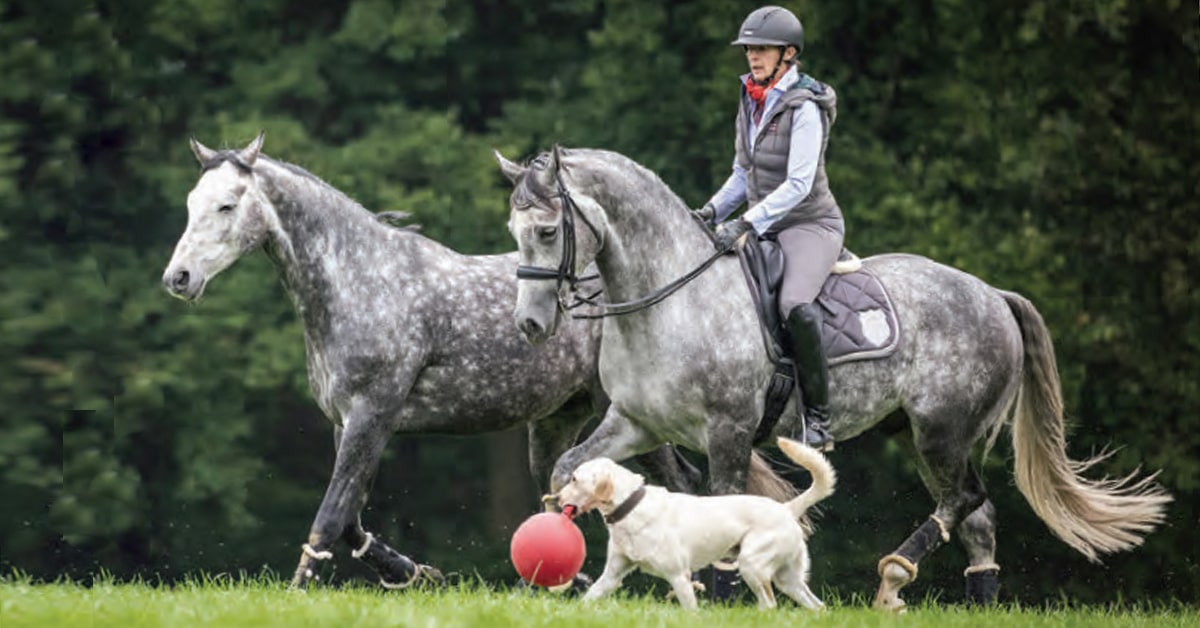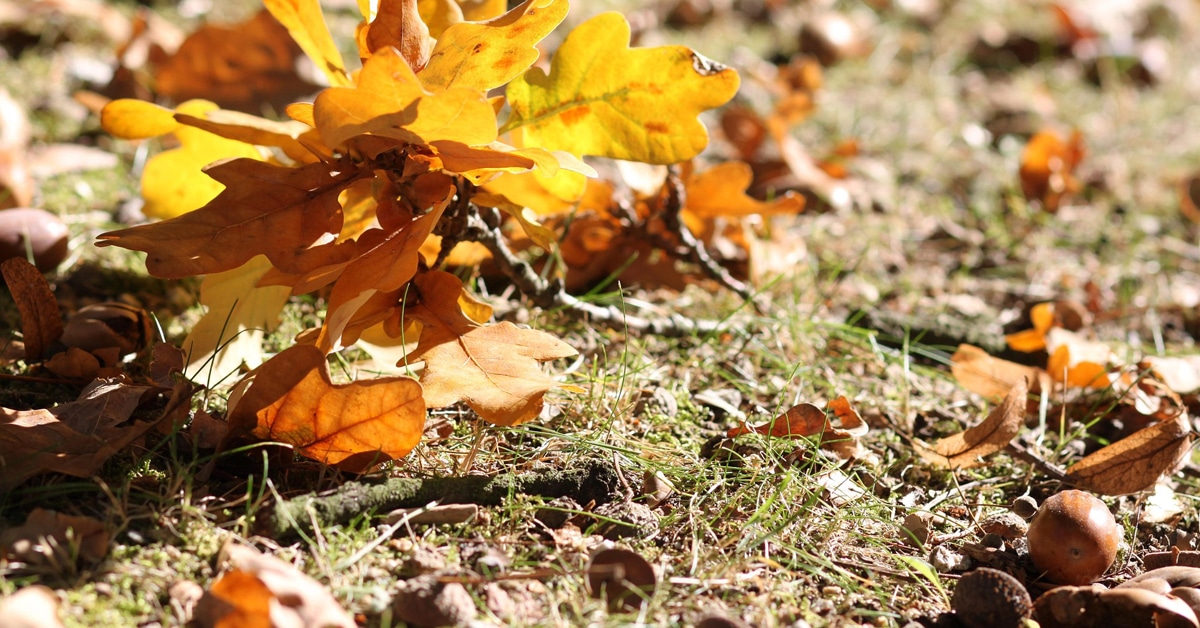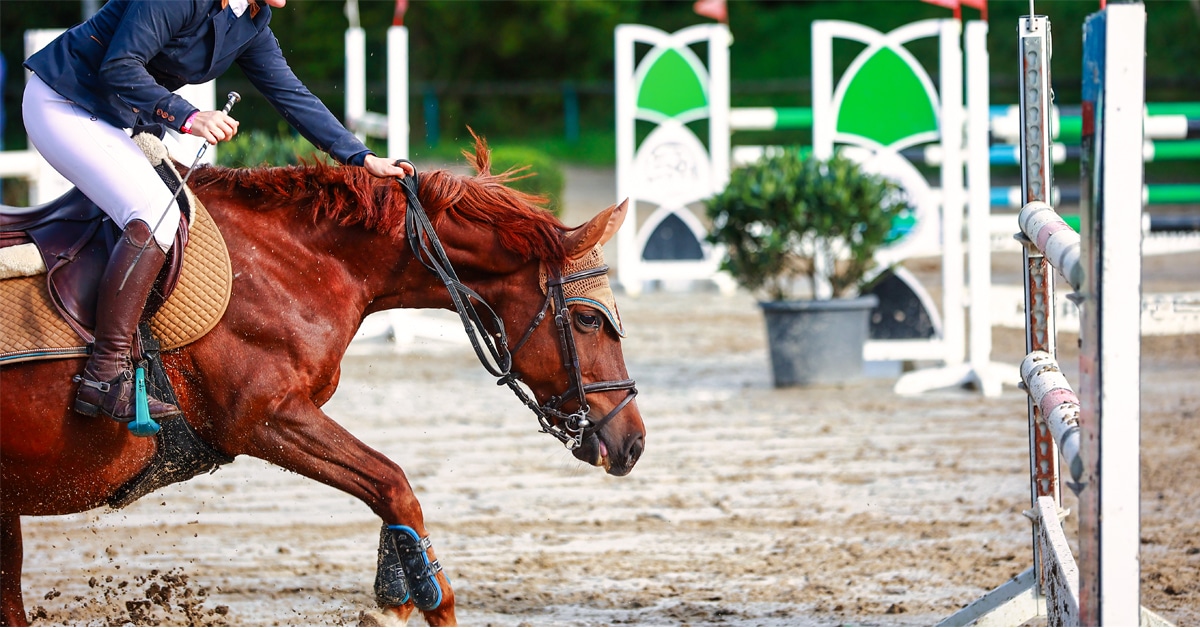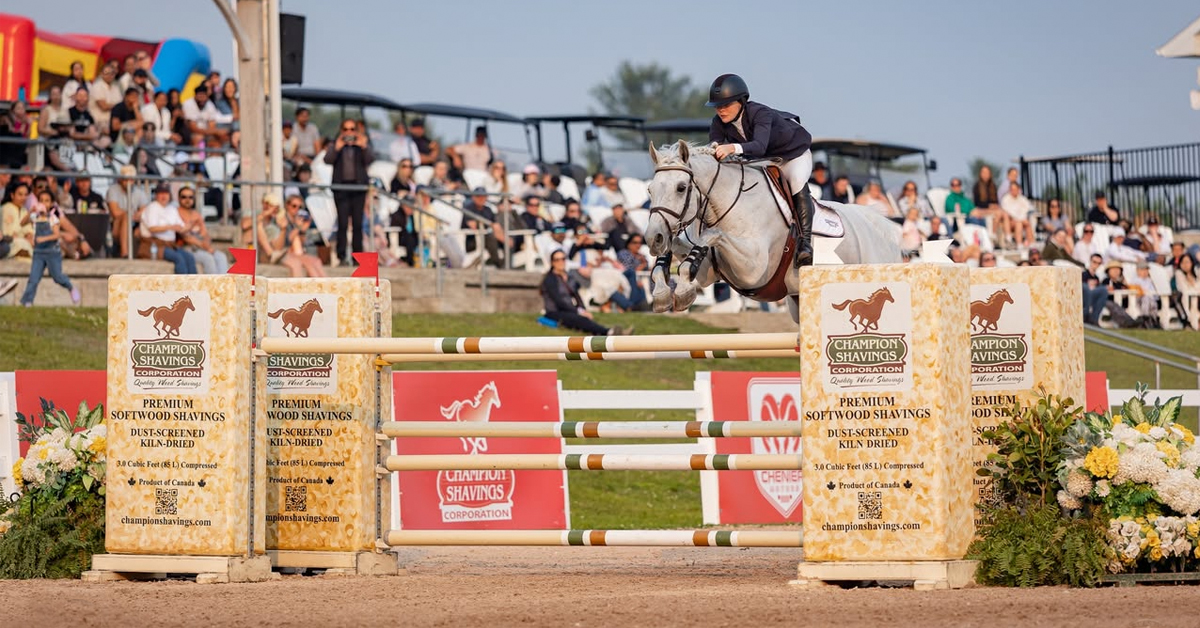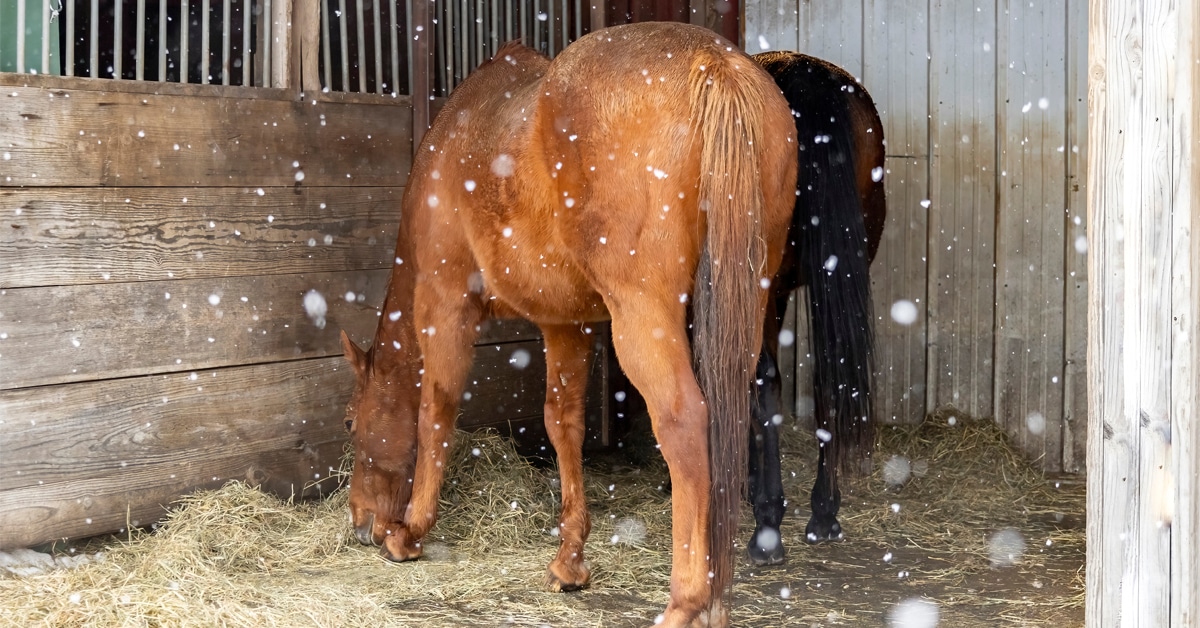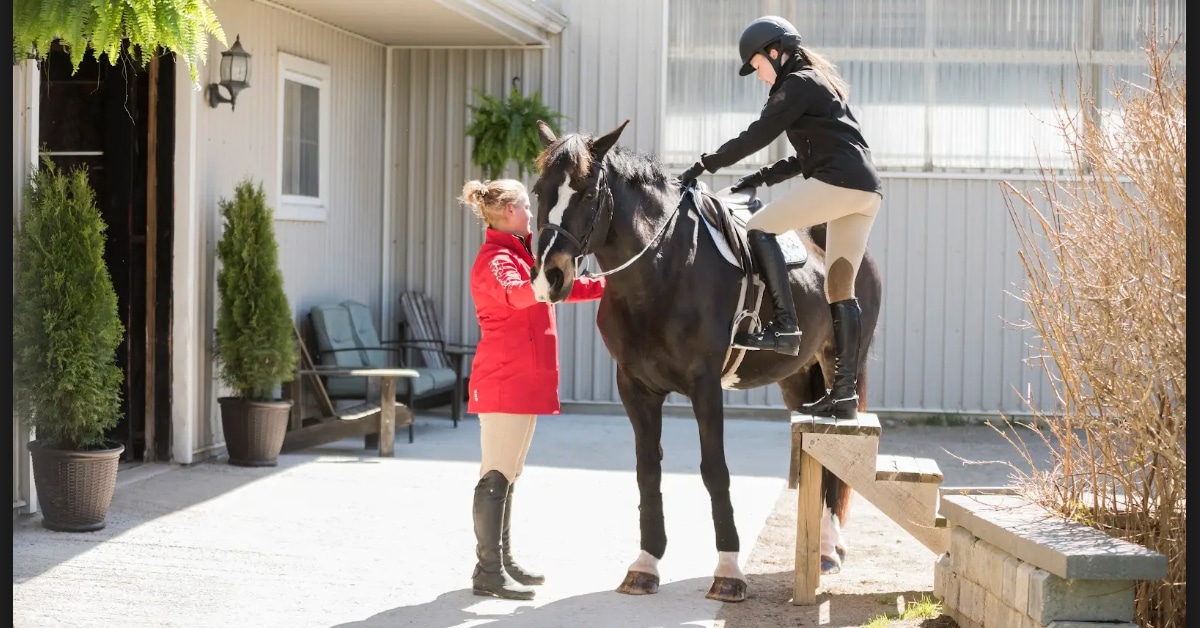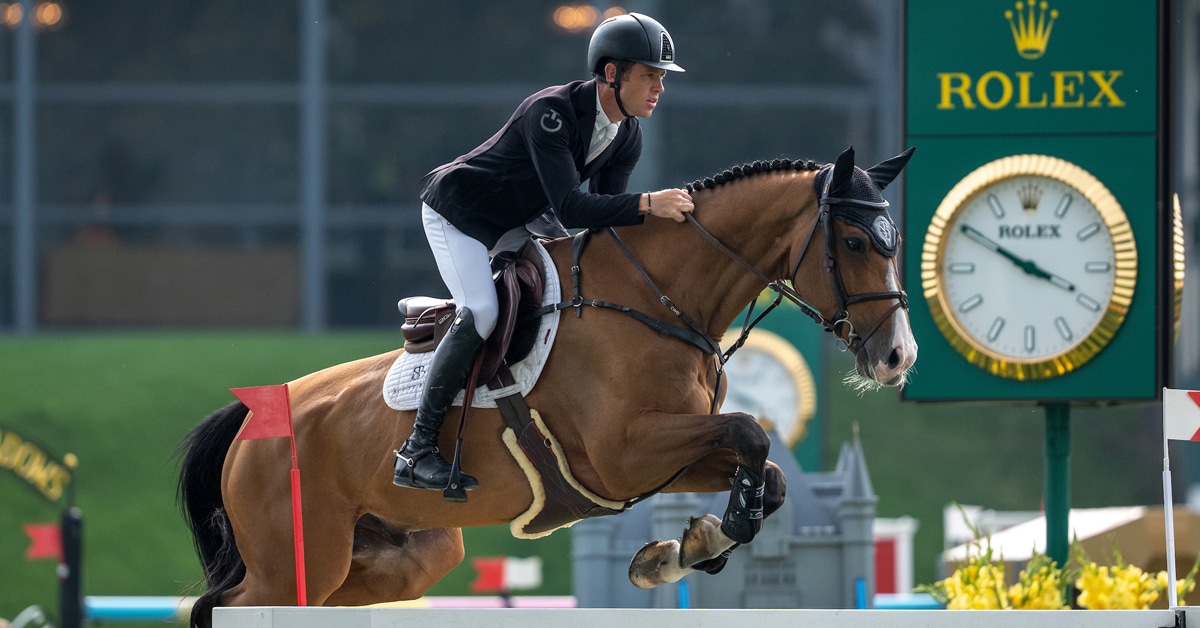An upper-level jumper stands in his electrically-wired paddock, fully awake but motionless. His eyes are open, his neck stretched out flat and parallel to his back. He takes little interest in the sounds, smells, or activities around him. He is not engaging with the horse next door. He is not eating – lunch was finished hours ago and there is still a long wait until dinner. In the grooming stall he is similarly disengaged – no nuzzling, no connection with his handler. The staff admit that he never gives them any trouble, yet they know that something is off. Is this horse depressed? And how would we know?
In lay language the term depressed generally refers to a temporary sad mood. In medical language, however, clinical depression is a complex, variable disorder which in humans involves the co-occurrence of several different emotional, cognitive, and behavioural changes such as low mood, anhedonia (the loss of pleasure in formerly pleasurable activities), changes in weight or appetite, sleep disturbances, increased agitation or the opposite – lethargy, feelings of worthlessness or guilt, low self-confidence, and recurrent thoughts of death or suicide. There are many potential combinations of symptoms that would all meet a clinical depression diagnosis which can present as opposite profiles; some presentations do not even seem depressed – such as hyperactivity and agitation. Being sad is not actually a necessary criterion for a diagnosis if the person experiences anhedonia.
Given depression’s variability in humans, how can we begin to diagnose depression in horses who cannot fill in questionnaires or participate in interviews, and who are hard-wired to keep their feelings close to their chest – you don’t want to look vulnerable when a predator may just be checking out the herd for a likely dinner candidate. (McFarland, 1999).
Do animals get depressed?
Using the diagnostic criteria for clinical depression outlined in the two prevailing diagnostic systems (DSM-5 and the ICD-10), Aileen MacLellan and her research group (2021) investigated whether a similar symptom pattern was evident in animals exposed to chronic stress either in a laboratory environment or in intensively managed agricultural systems. Although some depression diagnosis criteria cannot be measured in animals (when was the last time your horse talked to you about suicidal ideation?) many criteria such as inactivity, cognitive impairments, changes in weight and appetite, sleep disturbances, anhedonia, low affect, and numerous physiological markers of depression such abnormal cortisol levels can be objectively measured.
According to MacLellan, rats exposed to chronic stress for research purposes, intensively kept (high density) pigs, and caged laboratory mice demonstrate all the measurable diagnostic criteria and physiological biomarkers for a clinical depression diagnosis. However, in all these cases the criteria boxes are checked from different studies so, strictly speaking, we have yet to see the minimum five defining symptoms co-occurring in animals in the same study. MacLellan posits that is it is quite probable that some animals (especially those who are housed in intensely managed, artificial conditions) experience depression like human clinical depression, but we are still shy of the hard evidence to make that claim.
Do horses get depressed?
The Withdrawn Posture
Since we know horses can experience moods, emotions, and varied responses to stressors in their environment, presumably they can experience despair when they lose their agency to control adverse circumstances. Like the jumper in this article’s opening, researchers have found evidence of a withdrawn posture in horses living in impoverished environments. French researcher Carole Fureix and her colleagues (2012) saw this depressive like state in 24% of 59 active school horses; the horses stood motionless for long periods, with eyes wide open and a fixed flat stare, ears fixed and pointing slightly backward, head immobile, and neck stretched out flat. Compared to not-withdrawn horses from the same stable, these horses were disengaged and entirely unresponsive to humans and their surrounding environment.
Unlike resting horses (who usually rest one hind leg, with the neck low and round, muscles relaxed, ears rotated laterally, lips droopy, and eyes half-closed or closed), withdrawn horses are described by Fureix as switched off with ‘‘dull eyes looking nowhere’’ (2012). Notably, these horses also exhibited more reactivity when facing a challenging situation, such as the introduction of a new object in their environment (a common co-occurring characteristic of human depression) suggesting that they may be enduring a high state of anxiety belied by their outward affect.

Figure 1: Two types of riding school horses. (A) riding school horses presenting characteristic elements of posture associated with poor welfare. They all express stereotypies and abnormal repetitive behaviours (SB/ARB) and show “depressed-like” posture; (B) riding school horses which don’t express SB/ARB and “depressed-like” posture and without characteristic elements of posture associated with poor welfare (Sénèque, et al., 2019).
More recently, Emille Sénèque and colleagues (2019) taking dorsal (topline) measurements of 85 riding school horses from 11 lesson centres, found that horses with compromised welfare which were exhibiting stereotypies and abnormal repetitive behaviours or the depressed posture, and living in impoverished environments, tended to have flatter or even hollow dorsal profiles, particularly at their neck and croup. These findings corroborate and add to Fureix’s earlier work suggesting that poor welfare is associated with chronic changes in the horse’s posture that erases the natural curvature of the horse’s spine (See figure 1).
Anhedonia
Fureix’s team then tested whether these horses who looked clinically depressed experienced a defining criterion of human clinical depression, that of anhedonia – the loss of pleasure for formerly pleasurable activities (Fureix et al., 2015). Following the methodology that explored anhedonia in rats, by quantifying their normally voracious appetite for sugar, Fureix found that like chronically stressed rats, her withdrawn horses voluntarily consumed less sugar than non-withdrawn controls. (Typically, horses, like rats and people, appear to be sugar junkies – preferring sugar solutions to plain water, sweet feed to unsweetened feed, etc.). Withdrawn horses were also more likely to exhibit stereotypies such as cribbing, weaving, or stall walking – a known correlate of poor welfare – and lower plasma cortisol levels, a biomarker of human depression.
Disengagement
In a study of 27 horses (half of whom were previously identified as withdrawn and half not-withdrawn) Céline Rochais and colleagues (2016) exposed all horses to five novel sounds (vocalizations of a baboon, goose, whale, an unfamiliar horse, and piano music) over five days. Not-withdrawn horses were initially alarmed about the new broadcasts, but habituated to the sounds over time. Withdrawn horses, in contrast, appeared switched-off to the novel sounds and their response did not vary over the five days.
The researchers note that in human depression, negative emotional states draw on attention reserves and so interrupt attention toward novel events. Furthermore, the cognitive capacity of depressed individuals is limited, leaving them with a deficit for effortful cognitive processing such as focusing on important surrounding stimuli; instead, their attention is focused inward, characterized by their immobile stance (2016).
There is also evidence that horses who are apathetic in the stable carry this over to the arena. In a study of 43 horses observed in the stall and then under saddle, Alice Ruet (2020) found that horses’ expression of compromised welfare expressed in their loose boxes (stereotypies, aggressiveness toward humans, hypervigilant posture or alternatively switched-off and disengaged posture) was related to more defensive and/or discomfort behaviours under saddle. In particular, withdrawn horses in the stable were more reluctant to move forward under saddle, suggesting that the disengagement seen in the stall carries over to a negative perception of riding and other aspects of the horse’s world.
The authors concluded that social isolation appears to be so egregious an assault to the horse’s welfare that even modifications known to be beneficial in less extreme housing situations were insufficient to positively impact the horses’ adverse state.
In another study, Ruet’s team looked at the same four welfare indicators in a convenience sample (i.e. the aversive housing conditions were pre-existing and not created for the study) of 187 sport horses living in individual stalls and isolated from interaction with other horses (Ruet, et al., 2019). She also explored mitigating factors (grilled windows between stalls, exterior windows, feeding practices, riding discipline, training intensity, competition schedule, etc.) that could potentially ameliorate the horses’ welfare. Sadly, almost none of the management factors identified to be beneficial in previous research had a significant impact on the horses’ welfare. Most significantly, the longer horses lived in isolation, the more likely they were to express a total disengagement with their environment, suggestive of a depressive-like state. The authors concluded that social isolation appears to be so egregious an assault to the horse’s welfare that even modifications known to be beneficial in less extreme housing situations were insufficient to positively impact the horses’ adverse state.
Cognitive Bias
Studies of cognitive bias provide yet another way that researchers can tap into well-being and affective state. German researcher Sandra Löckener and collaborators (2015) trained horses to differentiate between a bucket that always produced a food reward, and another, located elsewhere, that did not. When horses could reliably discriminate between the jackpot reward bucket and the no-prize-here bucket, Löckener introduced a third unknown (empty) bucket located between the two. Horses living in individual box stalls with little chance of social interaction with other horses headed for the reliable jackpot bucket, but demonstrated little or no curiosity for the new bucket – a negative cognitive bias. However, ten days of herd turnout on pasture was sufficient to switch this bias around. When reintroduced to the situation with the unknown third bucket, horses were then much more likely to demonstrate a positive cognitive bias, investigating the unknown bucket, hopeful and for a positive payoff.
Henry and colleagues (2017) also found that horses living in social isolation exhibited more health-related problems, greater behavioral and postural indicators of a depressed state, and a greater likelihood of a pessimistic cognitive bias than horses living in natural conditions. These studies again demonstrate that social isolation negatively impacts physiological health and leaves horses in a depressed state that depletes their resources, compromises their cognitive abilities, and deadens their natural curiosity.
Learned Helplessness
The term, first coined by Martin Seligman (Seligman and Maier; 1967) was observed in a series of experiments that thankfully would not pass our ethics boards today. Seligman first put his 30 dogs in individual harnesses in an enclosed cubicle and administered shocks to their hind feet. Half of the dogs were able to immediately shut off the current by pressing a side panel with their head, and quickly learned to do so. The control dogs received the shock regardless of any attempts they made to escape them.
In the next phase, all dogs were placed in a room where the floor on which they were standing would, following the sound of a tone, become electrically charged, at which point the dogs could jump over a small barrier to avoid the shock. Dogs who had been given control to escape the shock in Phase I quickly learned to jump the barrier. Sadly, the control dogs, did nothing to escape their dire circumstances. In a follow-up one-week later, control dogs still failed to trial any strategy to escape the electrically charged floor, often lying down on the charged floor and whimpering, even when escape was possible.
Seligman identified three deficits in his laboratory dogs experiencing learned helplessness: Motivational (the dogs demonstrated no desire to escape the aversive electric shocks), Cognitive (they were unable to link their behaviour to a consistent outcome), and Emotional (their initial state of high anxiety morphed into a depressed flat affect). Furthermore, this apathy persisted long after the experiments had ceased. Further studies concluded that it was the uncontrollability of the shock, rather than the shock itself that induced the state of learned helplessness and so seriously compromised welfare.
Sadly, today’s typical management practices, where social isolation, limited foraging opportunities and a lack of agency are the norm, place horses at risk for experiencing a depressive state.
Equine researcher Carol Hall believes that horses also display signs of learned helplessness when they are subject to chronic, inescapable events either in their training, their management, or both (2008). She argues that initially learned helplessness can be seen as an adaptive strategy; if behaviour has no impact on consequences, it is resource costly to continue trialing new strategies. It becomes maladaptive, however, when over time it generalizes to the animal’s overall behavioural repertoire leading to loss of motivation, anhedonia, and health consequences such as ulcers and weight loss.
Since the deficits of learned helplessness observed by Seligman – passivity, submissiveness, and flat affect – often capture the very behaviours that we value in many equine disciplines (consider the bomb-proof school horse, the peanut-rolling western pleasure horse, or the “prepared” show hunter), a horse’s state of anguish may not only go unnoticed, but be actively pursued as an optimal training outcome, even by well-meaning owners and professionals (Hall, 2008).
How do we fix it?
Sadly, today’s typical management practices, where social isolation, limited foraging opportunities and a lack of agency are the norm, place horses at risk for experiencing a depressive state. I have written in previous articles about ways in which we can enhance equine well-being by letting horses live in more natural circumstances without compromising their safety. Herd living, or at least paired turn-out, is not crazy talk; it actually lowers the risk of injury and disease, lessens separation anxiety, makes horse more able to cope with temporary confinement, and greatly enhances well-being.
Chronic inescapable and uncontrollable stress also occurs all too often under saddle, again placing horses at risk for experiencing a depressed state. Paul McGreevy and Andrew McLean (2009) note that the simultaneous use of contradictory aids of acceleration and deceleration (common to novice riders, but also appearing in professional training) make horses likely candidates for experiencing learned helplessness. When aids are amplified with the use of harsher whoa-and-go aids (ever stronger bits and longer, sharper spurs) the likelihood is even greater. These researchers stress the importance of ethical equitation where the goal is to continually refine our aids to achieve the desired behaviour with the lightest signal possible (McGreevy & McLean, 2007; 2009).
Hall notes that the addition of positive reinforcement to traditional training could well improve the emotional well-being of at least some horses (Hall et al. 2020). Horses will generally learn a task whether trained with positive or negative reinforcement (i.e. the pressure and release that is common to most under saddle training). However, horses trained with positive reinforcement learn the task more quickly, retain the learned task longer, experience less stress, react to humans more positively, and generalize this knowledge across different trainers, novel tasks, and over longer periods of time (e.g. Sankey, 2010a; 2010b). Furthermore, positive reinforcement has been shown to increase motivation to participate in training, encourage exploratory behaviours, elevate mood, and induce a positive cognitive bias (Hall et al. 2020).
Upping my game
Since I usually try to inject some humour into my writing, I was dismayed to discover, upon proofing, that this article is not even marginally funny. Perhaps that is because the topic, equine depression, is … well … depressing. Once I explored the question of whether horses could experience depression as humans do, I was astounded at how often I saw this withdrawn posture where I had not seen it before.
As it stands, there is not yet sufficient evidence to say that these horses are experiencing clinical depression as it is described in the manuals. That said, it is clearly not indicative of optimal welfare, and now having seen it, I wonder how I could have missed it for so long.
We make a big ask of our sport horses and generally house them in ways that suit our needs first, and theirs rather poorly. They are hard-wired to be stoic, so their suffering is not always obvious. There is so much we can do to improve our sport horses’ psychological well-being – to make them the truly happy athletes that we want them to be. It requires, however, a sea change in our thinking and our management. I know I often take my horse’s willing and generous nature for granted when I make yet a bigger ask. Undoubtedly, I could up my game to become more vigilant about anything she might or might not be telling me.
The Latest
